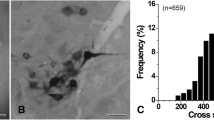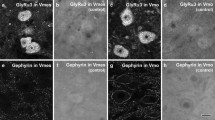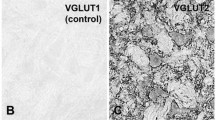Abstract
Gamma-motoneurons (γMNs) play a crucial role in regulating isometric muscle contraction. The slow jaw-closing during mastication is one of the most functional isometric contractions, which is developed by the rank-order recruitment of alpha-motoneurons (αMNs) in a manner that reflects the size distribution of αMNs. In a mouse spinal motor nucleus, there are two populations of small and large MNs; the former was identified as a population of γMNs based on the positive expression of the transcription factor estrogen-related receptor 3 (Err3) and negative expression of the neuronal DNA-binding protein NeuN, and the latter as that of αMNs based on the opposite pattern of immunoreactivity. However, the differential identification of αMNs and γMNs in the trigeminal motor nucleus (TMN) remains an assumption based on the size of cell bodies that were retrogradely stained with HRP. We here examined the size distributions of αMNs and γMNs in the dorsolateral TMN (dl-TMN) by performing immunohistochemistry using anti-Err3 and anti-NeuN antibodies. The dl-TMN was identified by immunopositivity for vesicular glutamate transporter-1. Immunostaining for choline acetyltransferase and Err3/NeuN revealed that the dl-TMN is composed of 65% αMNs and 35% γMNs. The size distribution of αMNs was bimodal, while that of γMNs was almost the same as that of the population of small αMNs, suggesting the presence of αMNs as small as γMNs. Consistent with the size concept of motor units, the presence of smaller jaw-closing αMNs was coherent with the inclusion of jaw-closing muscle fibers with smaller diameters compared to limb muscle fibers.




Similar content being viewed by others
References
Arber S, Ladle DR, Lin JH, Frank E, Jessell TM (2000) ETS gene Er81 controls the formation of functional connections between group Ia sensory afferents and motor neurons. Cell 101:485–498
Bae YC et al (2002) Quantitative ultrastructural analysis of glycine- and gamma-aminobutyric acid-immunoreactive terminals on trigeminal alpha- and gamma-motoneuron somata in the rat. J Comp Neurol 442:308–319
Bawa P, Binder MD, Ruenzel P, Henneman E (1984) Recruitment order of motoneurons in stretch reflexes is highly correlated with their axonal conduction velocity. J Neurophysiol 52:410–420
Boyd IA (1986) Two types of static gamma-axon in cat muscle spindles. Q J Exp Physiol 71:307–327
Burke RE, Strick PL, Kanda K, Kim CC, Walmsley B (1977) Anatomy of medial gastrocnemius and soleus motor nuclei in cat spinal cord. J Neurophysiol 40:667–680
Friese A, Kaltschmidt JA, Ladle DR, Sigrist M, Jessell TM, Arber S (2009) Gamma and alpha motor neurons distinguished by expression of transcription factor Err3. Proc Natl Acad Sci U S A 106:13588–13593
Hagbarth KE, Kunesch EJ, Nordin M, Schmidt R, Wallin EU (1986) Gamma loop contributing to maximal voluntary contractions in man. J Physiol 380:575–591
Henneman E, Somjen G, Carpenter DO (1965) Functional Significance of Cell Size in Spinal Motoneurons. J Neurophysiol 28:560–580
Hiiemae K, Houston W (1971) The structure and function of the jaw muscles in the rat (Ruffus norvegicus L.). Zool J Linn Soc 50:111–132
Hioki H, Fujiyama F, Taki K, Tomioka R, Furuta T, Tamamaki N, Kaneko T (2003) Differential distribution of vesicular glutamate transporters in the rat cerebellar cortex. Neuroscience 117:1–6
Hiraiwa T (1978) Histochemical properties of masticatory muscles of growing rat and matured mammals. Comp Biochem Physiol 59A:231–238
Kanning KC, Kaplan A, Henderson CE (2010) Motor neuron diversity in development and disease. Annu Rev Neurosci 33:409–440
Kubota K, Masegi T, Osanai K (1974) Proprioceptive innervation in the masticatory muscle of Temminck’s mole, Mogera wogura (Temminck, 1842). Anat Rec 179:375–383
Kuramoto E, Ohno S, Furuta T, Unzai T, Tanaka YR, Hioki H, Kaneko T (2015) Ventral medial nucleus neurons send thalamocortical afferents more widely and more preferentially to layer 1 than neurons of the ventral anterior-ventral lateral nuclear complex in the rat. Cereb Cortex 25:221–235
Limwongse V, DeSantis M (1977) Cell body locations and axonal pathways of neurons innervating muscles of mastication in the rat. Am J Anat 149:477–488
Mizuno N, Konishi A, Sato M (1975) Localization of masticatory motoneurons in the cat and rat by means of retrograde axonal transport of horseradish peroxidase. J Comp Neurol 164:105–115
Morimoto T, Inoue H, Kawamura Y (1982) Diameter spectra of sensory and motor fibers in nerves to jaw-closing and jaw-opening. Jap. J Physiol 32:171–182
Okamoto K et al. (2016) The possible role of TASK channels in rank-ordered recruitment of motoneurons in the dorsolateral part of the trigeminal motor nucleus. eNeuro 3:3
Onda S (1984) Myofibrous organization of the masseter muscle of rats. Showa Med J 44:523–529
Osterlund C, Liu JX, Thornell LE, Eriksson PO (2011) Muscle spindle composition and distribution in human young masseter and biceps brachii muscles reveal early growth and maturation. Anat Rec (Hoboken) 294:683–693
Pang YW, Ge SN, Nakamura KC, Li JL, Xiong KH, Kaneko T, Mizuno N (2009) Axon terminals expressing vesicular glutamate transporter VGLUT1 or VGLUT2 within the trigeminal motor nucleus of the rat: origins and distribution patterns. J Comp Neurol 512:595–612
Rokx JT, van Willigen JD, Juch PJ (1985) Distribution of innervating neurons of masticatory muscle spindles in the rat: an HRP study. Exp Neurol 88:562–569
Rokx JT, Liem RS, van Willigen JD (1987) Identification of alpha and gamma trigeminal motoneurons by the vibratome paraplast technique for HRP histochemistry. Acta Anat (Basel) 129:333–336
Suzuki A (1977) A comparative histochemical study of the masseter muscle of the cattle, sheep, swine, dog, guinea pig, and rat. Histochemistry 51:121–131
Talmadge RJ, Roy RR (1993) Electrophoretic separation of rat skeletal muscle myosin heavy-chain isoforms. J Appl Physiol 75:2337–2340
Thexton AJ, Griffiths C (1979) Reflex oral activity in decerebrate rats of different age. Brain Res 175:1–9
Tourtellotte WG, Milbrandt J (1998) Sensory ataxia and muscle spindle agenesis in mice lacking the transcription factor Egr3. Nat Genet 20:87–91
Tsukamoto S, Mori M (1966) Distribution of muscle fibers of three types of differentiated by succinic dehydrogenase activity in the skeletal muscle. Arch Histol Jpn 26:329–339
Tsukiboshi T et al (2012) Illusion caused by vibration of muscle spindles reveals an involvement of muscle spindle inputs in regulating isometric contraction of masseter muscles. J Neurophysiol 108:2524–2533
Tuxen A, Kirkeby S (1990) An animal model for human masseter muscle: histochemical characterization of mouse, rat, rabbit, cat, dog, pig, and cow masseter muscle. J Oral Maxillofac Surg 48:1063–1067
Vallbo AB (1970) Slowly adapting muscle receptors in man. Acta Physiol Scand 78:315–333
Westneat MW, Hall WG (1992) Ontogeny of feeding motor patterns in infant rats: an electromyographic analysis of suckling and chewing. Behav Neurosci 106:539–554
Yemm R (1977) The orderly recruitment of motor units of the masseter and temporal muscles during voluntary isometric contraction in man. J Physiol 265:163–174
Acknowledgements
This study was mainly supported by a Grant-in-Aid for Scientific Research to Y.K. (B; 26290006) and was partly supported by Brain Pool Program through the Korean Federation of Science and Technology Societies (KOFST), funded by the Ministry of Science, ICT and Future Planning.
Author information
Authors and Affiliations
Corresponding author
Ethics declarations
Conflict of interest
The authors declare that they have no conflict of interest.
Rights and permissions
About this article
Cite this article
Morita-Isogai, Y., Sato, H., Saito, M. et al. A distinct functional distribution of α and γ motoneurons in the rat trigeminal motor nucleus. Brain Struct Funct 222, 3231–3239 (2017). https://doi.org/10.1007/s00429-017-1400-8
Received:
Accepted:
Published:
Issue Date:
DOI: https://doi.org/10.1007/s00429-017-1400-8




